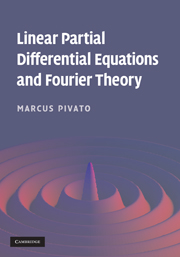Book contents
- Frontmatter
- Contents
- Preface
- What's good about this book?
- Suggested 12-week syllabus
- Part I Motivating examples and major applications
- Part II General theory
- Part III Fourier series on bounded domains
- Part IV BVP solutions via eigenfunction expansions
- Part V Miscellaneous solution methods
- Part VI Fourier transforms on unbounded domains
- Appendix A Sets and functions
- Appendix B Derivatives – notation
- Appendix C Complex numbers
- Appendix D Coordinate systems and domains
- Appendix E Vector calculus
- Appendix F Differentiation of function series
- Appendix G Differentiation of integrals
- Appendix H Taylor polynomials
- References
- Subject index
- Notation index
Part II - General theory
Published online by Cambridge University Press: 05 June 2012
- Frontmatter
- Contents
- Preface
- What's good about this book?
- Suggested 12-week syllabus
- Part I Motivating examples and major applications
- Part II General theory
- Part III Fourier series on bounded domains
- Part IV BVP solutions via eigenfunction expansions
- Part V Miscellaneous solution methods
- Part VI Fourier transforms on unbounded domains
- Appendix A Sets and functions
- Appendix B Derivatives – notation
- Appendix C Complex numbers
- Appendix D Coordinate systems and domains
- Appendix E Vector calculus
- Appendix F Differentiation of function series
- Appendix G Differentiation of integrals
- Appendix H Taylor polynomials
- References
- Subject index
- Notation index
Summary
Differential equations encode the underlying dynamical laws which govern a physical system. But a physical system is more than an abstract collection of laws; it is a specific configuration of matter and energy, which begins in a specific initial state (mathematically encoded as initial conditions) and which is embedded in a specific environment (encoded by certain boundary conditions). Thus, to model this physical system, we must find functions that satisfy the underlying differential equations, while simultaneously satisfying these initial conditions and boundary conditions; this is called an initial/boundary value problem (I/BVP).
Before we can develop solution methods for PDEs in general, and I/BVPs in particular, we must answer some qualitative questions. Under what conditions does a solution even exist? If it exists, is it unique? If the solution is not unique, then how can we parameterize the set of all possible solutions? Does this set have some kind of order or structure?
The beauty of linear differential equations is that linearity makes these questions much easier to answer. A linear PDE can be seen as a linear equation in an infinite-dimensional vector space, where the ‘vectors’ are functions. Most of the methods and concepts of linear algebra can be translated almost verbatim into this context. In particular, the set of solutions to a homogeneous linear PDE (or homogeneous linear I/BVP) forms a linear subspace.
- Type
- Chapter
- Information
- Linear Partial Differential Equations and Fourier Theory , pp. 59 - 60Publisher: Cambridge University PressPrint publication year: 2010



